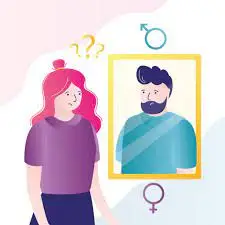In this comprehensive guide, we’re going to delve deep into the topic of gender dysphoria – a term you might have heard but perhaps don’t fully understand. We’ll start by laying the groundwork, explaining what gender dysphoria is, and highlighting the signs and symptoms that may indicate its presence. Also, we’ll uncover how professional counseling can help you cope with feelings of gender dysphoria. So let’s dive in!
Contents
What Is Gender Dysphoria?
 Gender dysphoria is a term used in clinical settings to describe the psychological distress that results from an incongruity between one’s sex assigned at birth and one’s gender identity. This distress may encompass a range of feelings, from discomfort to intense dissatisfaction, and is associated with a strong desire to live as one’s identified gender rather than the gender traditionally associated with one’s physical or biological characteristics. It’s crucial to understand that this incongruity is deeply personal and is experienced uniquely by each individual.
Gender dysphoria is a term used in clinical settings to describe the psychological distress that results from an incongruity between one’s sex assigned at birth and one’s gender identity. This distress may encompass a range of feelings, from discomfort to intense dissatisfaction, and is associated with a strong desire to live as one’s identified gender rather than the gender traditionally associated with one’s physical or biological characteristics. It’s crucial to understand that this incongruity is deeply personal and is experienced uniquely by each individual.
What are the Signs of Gender Dysphoria?
Gender dysphoria is unique to each individual, and therefore, the signs can vary significantly. Generally, signs of gender dysphoria may include a strong desire to be of a different gender than the one assigned at birth. This can manifest in a variety of ways, including:
- A deep discomfort with one’s body, particularly with physical changes during puberty.
- A strong wish to remove or alter physical signs of one’s biological sex, such as facial hair or breasts.
- An intense longing to have physical characteristics that match one’s identified gender.
- A steadfast insistence that they are, or want to be, the other gender.
- Preference for clothing, hairstyles, toys, and roles typically associated with the other gender.
- Persistent feelings of discomfort with one’s current gender role or identity.
It’s crucial to note that these signs are not exhaustive and they may vary based on age, cultural context, and individual circumstances.
Challenges That One May Face With This Discomfort
Living with gender dysphoria can present a myriad of challenges, both psychological and social, which can profoundly impact an individual’s quality of life. Here are some of the potential challenges:
Psychological Challenges

- Mental Health Issues: Many individuals with gender dysphoria experience mental health problems such as depression, anxiety, self-harm tendencies, and even suicidal thoughts. This often results from the ongoing distress of living in a body that doesn’t align with their gender identity.
- Emotional Distress: Feelings of isolation, shame, guilt, or confusion are common, particularly if the individual feels unsupported or misunderstood.
- Body Image Issues: Discontent with one’s physical appearance can lead to negative body image and low self-esteem.
Social Challenges
- Discrimination and Stigma: Individuals with gender dysphoria often face societal stigma, discrimination, or harassment, leading to marginalization and exclusion.
- Rejection by Family and Friends: Coming out to family and friends can result in rejection or unsupportive responses, leading to strained relationships.
- Workplace Challenges: Some people may encounter difficulties at work, such as discrimination, misunderstanding from colleagues, or lack of gender-neutral facilities.
- Healthcare Access: Finding competent, sensitive healthcare providers and services can be challenging, often resulting in inadequate or inappropriate medical care.
- Legal Issues: In many regions, legal recognition of one’s affirmed gender can involve a complex and challenging process, affecting everything from identification documents to employment and housing rights.
How Can It Be Treated?
 Treatment for gender dysphoria aims to help individuals manage their distress and achieve a state of well-being where they feel comfortable with their gender identity. It’s important to note that treatments are highly individualized, as what might be helpful for one person may not be for another. Here are some common approaches:
Treatment for gender dysphoria aims to help individuals manage their distress and achieve a state of well-being where they feel comfortable with their gender identity. It’s important to note that treatments are highly individualized, as what might be helpful for one person may not be for another. Here are some common approaches:
- Counseling and Psychotherapy: This is often the first step in treatment. A mental health professional, especially one with experience in gender identity issues, can provide invaluable support. They can help the individual explore their feelings about their gender, cope with societal attitudes, or deal with relationship issues.
- Support Groups: Connecting with others who are going through similar experiences can offer emotional support and shared coping strategies.
- Hormone Therapy: For some, hormone therapy (such as testosterone or estrogen) can help align their physical appearance more closely with their gender identity and reduce distress.
- Gender-Affirming Surgery: Also known as sex reassignment surgery, this involves surgical procedures that change the body to better align with the person’s gender identity.
- Social and Legal Transition: This includes living and identifying as the gender with which one identifies, and may involve changing one’s name, clothing, or pronouns. Legal transition may also include changing gender markers on identification documents.
- Voice Therapy: Some individuals may choose to work with a speech-language pathologist to alter their voice so that it aligns more closely with their gender identity.
- Support for Family and Friends: Educating family members and friends can help them provide the necessary support and understanding to their loved ones.
How Counseling Can Help With Gender Dysphoria?

Counseling plays a crucial role in supporting individuals with gender dysphoria. With a compassionate and understanding approach, therapists can provide a safe space for exploration, understanding, and acceptance. Here’s how counseling can assist:
- Self-Exploration: A counselor can provide a non-judgmental space for individuals to explore their gender identity, feelings, and concerns. This process can assist in understanding one’s feelings and experiences related to gender dysphoria.
- Coping Strategies: Therapists can help individuals develop effective coping mechanisms to manage the psychological distress associated with gender dysphoria. Techniques such as mindfulness, cognitive-behavioral strategies, and stress management can be useful.
- Support Through Transition: If an individual chooses to undergo social or medical transition, a therapist can offer emotional support and guidance throughout the process. This can include preparing for hormone therapy or surgery, coming out to family, friends, or colleagues, and adjusting to new social roles and expectations.
- Dealing with Discrimination and Stigma: Counseling can help equip individuals with strategies to handle societal prejudice, discrimination, and stigma, promoting resilience and self-advocacy.
- Family and Relationship Counseling: Therapists can also work with families and partners, helping them understand gender dysphoria and providing strategies to support their loved ones.
- Referral to Other Services: Therapists can often provide valuable referrals to other professionals or services as needed, such as medical doctors for hormone therapy, support groups, or legal assistance.
- Mental Health Support: As mental health issues such as anxiety and depression are common among individuals with gender dysphoria, therapists can provide treatments for these conditions concurrently.
Conclusion
Understanding gender dysphoria and its implications is a journey, both for those who experience it and for those who wish to support them. The challenges it presents can be multifaceted, touching every aspect of an individual’s life, from their psychological well-being to their social interactions and personal relationships. But with these challenges come opportunities for profound personal growth and self-discovery.
Counseling, in particular, can be a powerful tool for managing and navigating the complexities of gender dysphoria, offering valuable support, guidance, and strategies for coping.


